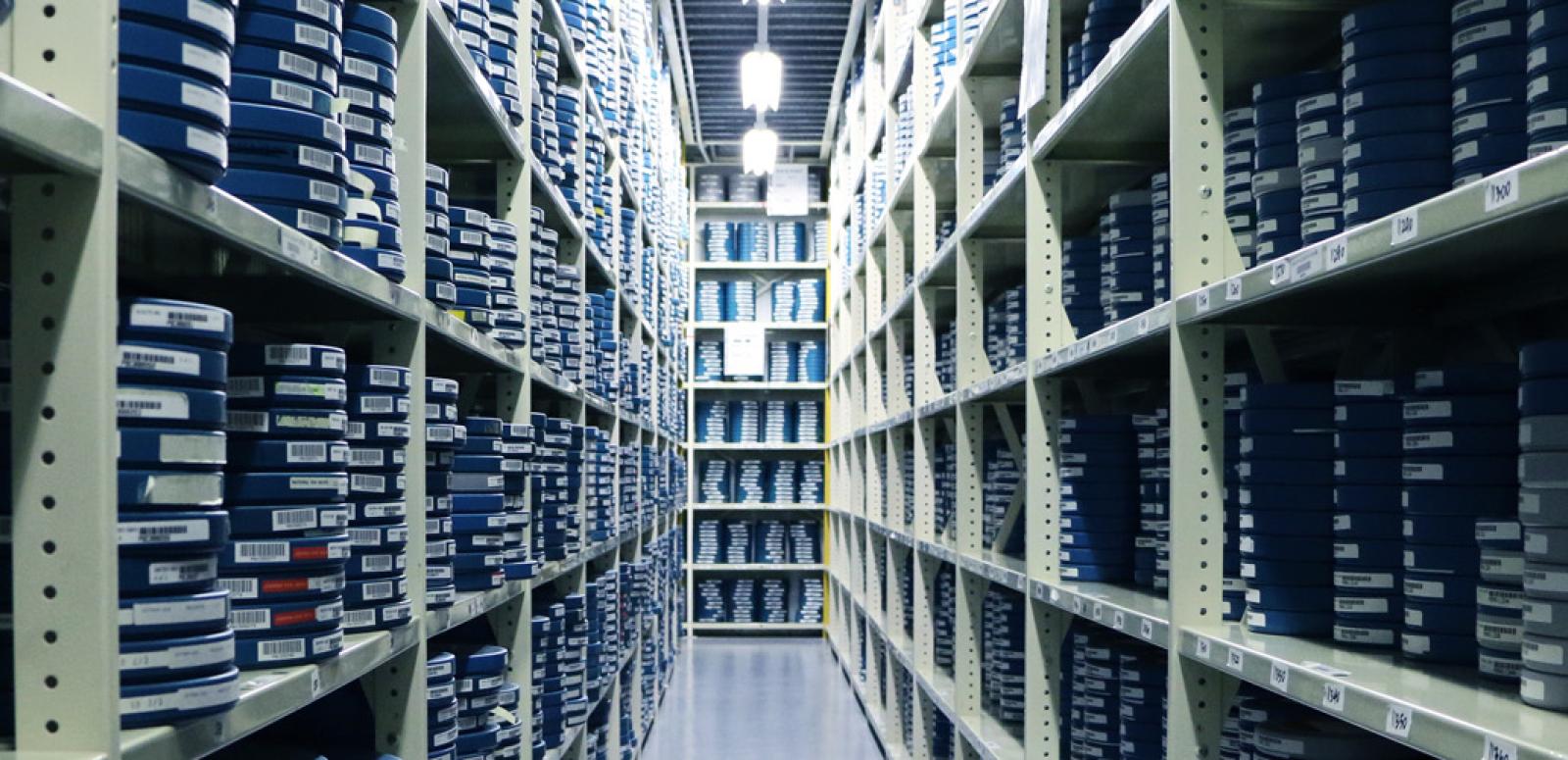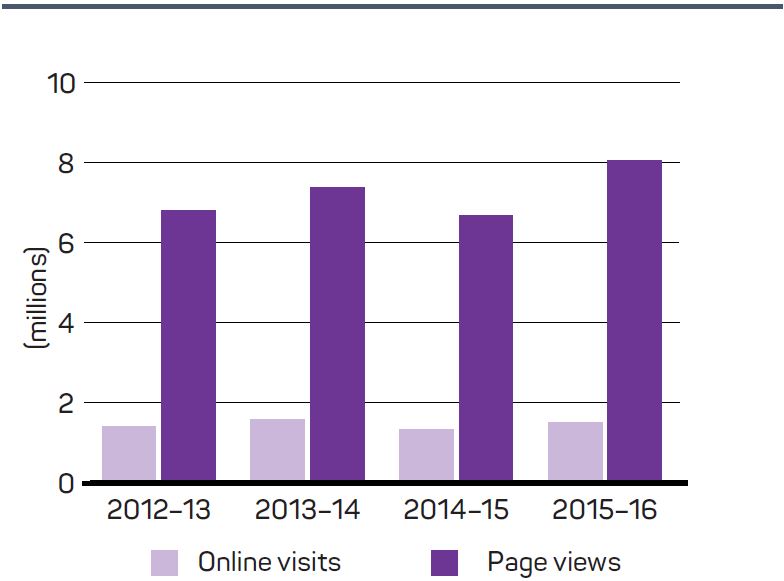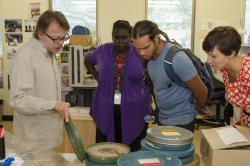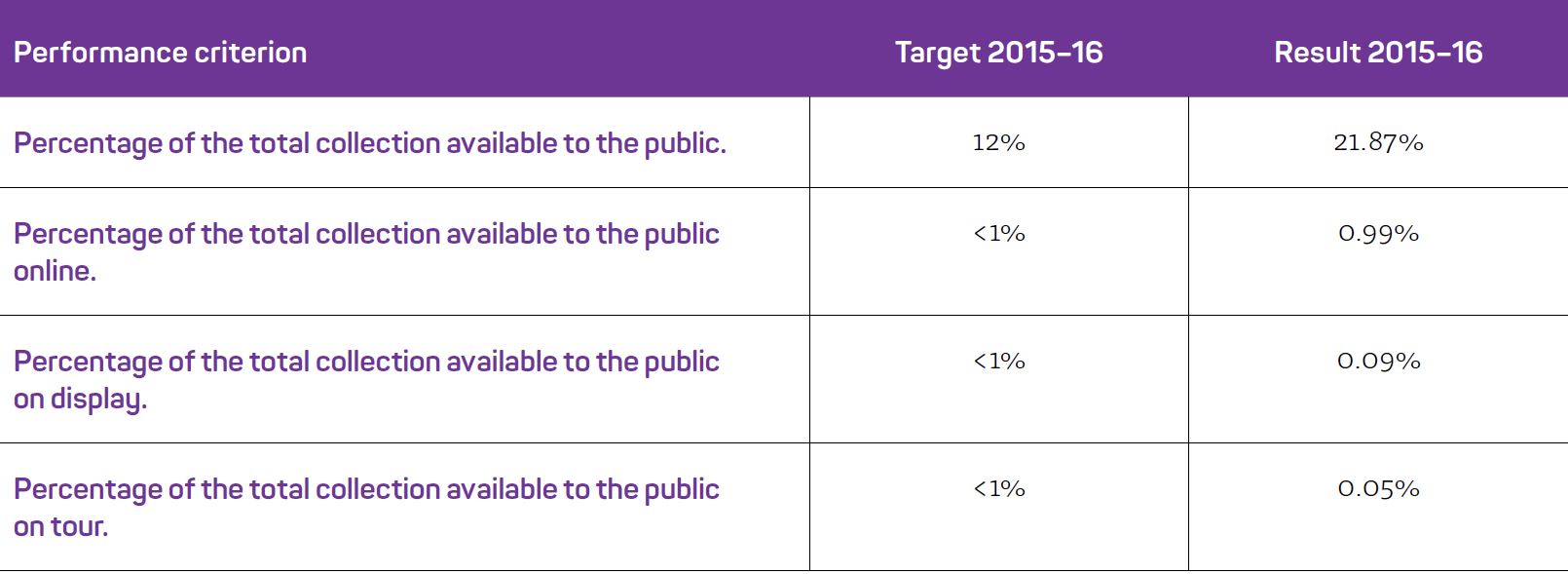

Annual Report 2015-16
Purpose 3: Sharing the collection
In the digital age, audiences expect increased interactive access to the collections preserved by cultural institutions. We respond to this need by diversifying the offering in our physical spaces and developing rich, engaging experiences that the general public can explore online.
Access to the collection in the current technological environment is characterised by users’ expectations of being part of a two-way exchange. Audiences embrace the notion of collective ownership of their national estate. Instead of ‘granting access’ we wish to share the collection and engage users any time, any place.

Figure 6: Number of online visits, 2012–13 to 2015–16
Table 2: Number of public program participants by category 2015–16
| Public program | Result 2015–16 |
| Online exhibitions | 10,589 |
| Arc Cinema screenings, Acton | 12,713 |
| Black Screen touring program | 7,955 |
| National events (off-site) | 8,122 |
| Canberra public programs and events | 860 |
| Total public program participants | 40,239 |
snapshot2
David Bowie on The Don Lane show

Immediately following the death of David Bowie on 10 January 2016, we published a memorable 1983 Australian interview with the music legend.
While dining at a Melbourne restaurant during his Serious Moonlight world tour, David Bowie noticed that the last-ever episode of The Don Lane Show (1975–1983) was screening live on television. A fan of the program from previous visits to Australia, he went straight to the nearby studio to offer himself as an impromptu interview guest. At the time, Bowie said it was the first time he had ever appeared on a television talk show.
In the wake of Bowie’s death, we were able to digitise and publish this footage (courtesy of the Nine Network), and it was an immediate hit with social media audiences. It became our most popular Facebook post to date, reaching an estimated audience of 51,825 unique users.
Results: SHARING the Collection

Pathway 3.1.1 PROGRAMMING
In December 2015 our Board approved a new Community Engagement Strategy for the NFSA. This strategy outlines a vision of the NFSA as a facilitator and broker, building a national profile of engagement activities based on a network of partnerships and strong links to the collection.
We subsequently developed a three-year Community Engagement Plan which was finalised in April 2016. As part of this plan, in 2016 we moved to a new approach to our Canberra-based programming. Annual themes now provide a central narrative for our screening and event-based activity, and as the basis for exploring certain aspects of the collection. The 2016 theme, Identity, looked at notions of national identity in the Australian context, including the birth of Australia as a nation, Indigenous identity, immigration, and the impact of landscape on Australian national identity.
| Criterion source: 2015–16 Corporate Plan page 9 |
| Strategic Priority 1: A ‘living’ archive – for everyone |

Pathway 3.1.2 VISITORS
We exceeded our target of 100,000 visits to the NFSA for the financial year. This figure includes onsite and offsite visitors to the NFSA, taking into account visitor numbers to our Acton headquarters, state access centres, mediatheque (at the Australian Centre for the Moving Image in Melbourne), and audiences for both theatrical and non-theatrical screenings (both nationally and internationally).
In 2015–16 visitor numbers to our Acton headquarters were lower than in previous years. This was the result of our strategic decision to cease offering permanent exhibitions at our Acton headquarters. Instead, we are focusing on building our national online profile, including through a series of high-quality online exhibitions, which will provide access for a wider audience across Australia. We continued to offer education programs, daily screenings and special events at our Acton site.
| Criterion source: Program 1.1, 2015–16 Portfolio Budget Statements page 376, 2015–16 Corporate Plan page 10, cross-agency performance indicator |
| Strategic Priority 1: A ‘living’ archive – for everyone |

Pathway 3.1.3 PUBLIC PROGRAMS
A number of events across the 2015–16 year enjoyed good patronage, a high level of positive audience feedback, and success in developing relationships and partnerships for the NFSA to draw on in future years. A new quarterly program of activity was delivered in line with the new Community Engagement Strategy, including screenings and special events.
From this year we have started to include figures for our ‘online exhibition unique visits’ to our public programs. This year we had 10,589 unique visits to our online exhibitions, demonstrating our capacity to engage with visitors online by providing curated experiences (see figure 6 and table 2).
| Criterion source: Program 1.1, 2015–16 Portfolio Budget Statements page 376, 2015–16 Corporate Plan page 9, cross-agency performance indicator |
| Strategic Priority 1: A ‘living’ archive – for everyone |

Pathway 3.1.3 PUBLIC PROGRAMS
We undertook public programming surveys in June 2016 that targeted three different public programs that we ran: a Ghost Tour, our Eurovision Superfan party, and our Star Stories event. We received 54 survey responses, of which 48 recorded respondents being ‘satisfied’ or ‘highly satisfied’ with their overall experience. We will continue to conduct further public program surveys in 2016–17.
| Criterion source: Program 1.1, 2015–16 Portfolio Budget Statements page 377, 2015–16 Corporate Plan page 9, cross-agency performance indicator |
| Strategic Priority 1: A ‘living’ archive – for everyone |
case study 3:
Helping Indigenous communities build capacity on country
In 2015 we partnered with the Indigenous Remote Communications Association (IRCA) to offer two remote media and archive workers the opportunity to travel to the NFSA in Canberra to receive professional training.
The Indigenous Remote Archival Fellowship Program was designed to enable these workers to experience and learn from the experts responsible for developing and preserving Australia’s national audiovisual collection.
The program builds on the work undertaken by the NFSA, IRCA and other stakeholders in developing a national remote archiving strategy. Many Indigenous communities have their own audiovisual archives, particularly those across the deserts and top end of Australia. One of our strategic priorities is to help Indigenous communities build the capacity to manage their own cultural material on-country.
The successful fellows for this year were announced at the 17th National Remote Indigenous Media Festival in Lajamanu, Northern Territory, in October 2015. They were Sherika Nulgit (from Mowanjum Aboriginal Art and Culture in Derby, in north-west Western Australia) and Shaun Angeles (from the Strehlow Research Centre in Alice Springs).
Sherika and Shaun completed their fellowships in March 2016. They experienced each element of the NFSA’s functions and then each fellow selected an area of particular interest or relevance to their community to follow up on in greater detail.
During their time in Canberra, both Sherika and Shaun took the opportunity to connect with Indigenous cultural leaders at the National Museum of Australia for the Encounters conference. They also reviewed the collections at the Australian Institute of Aboriginal and Torres Strait Islander Studies (AIATSIS). In addition, they visited the Sydney office to engage with our staff there and to explore training opportunities at Sydney University and the Australian Film, Television and Radio School.
The aim of the Indigenous Remote Archival Fellowship Program is to build and connect people working on-country with those working at the NFSA. This connection strengthens a greater appreciation of the benefits of shared learnings towards the management and preservation of cultural collections. For Shaun, whose work at the Strehlow Research Centre delivers immeasurable benefits to his community, a strong connection to the NFSA enhances his ability to perform his role. He believes the NFSA has a really special role in relation to cultural maintenance and preservation and that the program should be supported.

As Shaun says, “There are many young Indigenous people out there in cultural institutions and art centres and research centres in our communities all over Australia.For young people to have this same opportunity can only be a good thing.”
In 2016–17 the NFSA, IRCA, and AIATSIS will seek additional funding to extend this successful training initiative by one week.

Pathway 3.1.4 ONLINE VISITS
We continue to share our collection and engage with new audiences through our website and social media channels. The public has an appetite for content and the scope of the collection ensures that we can serve their demand for online entertainment, education, history and culture.
| Criterion source: Program 1.1, 2015–16 Portfolio Budget Statements page 376, 2015–16 Corporate Plan page 10, cross-agency performance indicator |
| Strategic Priority 1: A ‘living’ archive – for everyone |

Pathway 3.1.5 SOCIAL MEDIA ENGAGEMENT
The NFSA Films YouTube channel has surpassed our target of one million views for the financial year, resulting in 1.65 million views, with an average view duration of four minutes. Australia accounts for 12% of all views, followed by the United States of America, United Kingdom, India and Canada. It is a young audience, with 26.7% in the 25–34 age bracket.
The channel regularly generates content sales and media opportunities in both Australia and overseas. Films such as Crocodile Hunters resulted in national ABC coverage as well as stories in Mashable and The Telegraph (UK).
| Criterion source: 2015–16 Corporate Plan page 10 |
| Strategic Priority 1: A ‘living’ archive – for everyone |

Pathway 3.1.5 SOCIAL MEDIA ENGAGEMENT
On Facebook, we average a reach of 50,000 unique users every month, with a sizeable proportion (15%) of our Facebook followers being females in the 25–34 age bracket. Social media allows us to start a conversation with our audiences and we have steadily increased our engagement, with a monthly average 10,000 likes, shares and comments. We have also almost doubled our target of 1,000 new Facebook followers for the financial year, with 1,997 new followers bringing us to a total of approximately 7,000 followers. For more information about sharing collection content via social media, see the snapshot, ‘David Bowie on the Don Lane Show’, on page 30.
| Criterion source: 2015–16 Corporate Plan page 10 |
| Strategic Priority 1: A ‘living’ archive – for everyone |

Pathway 3.1.6 ONLINE EXHIBITIONS
We developed and delivered two online exhibitions in 2015–16.
To mark 40 years since the release of one of Australia’s best-known films, Picnic at Hanging Rock, we published an extensive selection of collection materials with the blessing of director, Peter Weir. These included previously unseen outtakes, 360-degree photography of costumes from the film, props, cast and crew oral history interviews, posters, lobby cards, scripts and production documents.
On Johnny O’Keefe’s birthday, we launched the exhibition, Johnny O’Keefe: a little bit louder now. This celebrated the iconic rocker’s legacy with television footage, concert programs, rare recordings, memorabilia and two scrapbooks compiled by his mother at the height of his fame. These exhibitions allow us to exhibit fragile collection items – like the scrapbooks – to all Australians without risk of damaging them.
We received 10,589 unique visits to our online exhibitions throughout the financial year, including online exhibitions delivered in 2014–15: Muriel’s Wedding and Priscilla. This number of visitors is included in our public program attendees figure (see table 2 and Pathway 3.1.3: Public programs).
| Criterion source: 2015–16 Corporate Plan page 10 |
| Strategic Priority 1: A ‘living’ archive – for everyone |

Pathway 3.1.7 PARTNERSHIPS
Our partnership with the Australian Centre for the Moving Image (ACMI), in Melbourne, was renewed on 6 June 2016 with the signing of a new memorandum of understanding (MoU) between our organisations. The MoU is aimed at increasing engagement between our organisations and outlines how we may work on future joint activities and initiatives. The NFSA and ACMI have worked in partnership since 2009. However, both organisations consider it timely to implement a new strategic vision to re-invigorate visitor engagement at the ACMI site in Melbourne (which hosts a wealth of NFSA-sourced content). As a first step in closer alignment and mutually beneficial outcomes, the NFSA and ACMI have shared office space at ACMI X in Melbourne’s Southbank arts precinct since April 2016.
| Criterion source: 2015–16 Corporate Plan page 10 |
| Strategic Priority 1: A ‘living’ archive – for everyone |

We continue to work closely with our stakeholders and partners in state and territory capitals to deliver ongoing programs and exhibitions.
We continue to collaborate with the National Museum of Australia (NMA) in developing and presenting engaging curated audiovisual works relating to World War 1. This integrated approach introduces the mass of NMA visitors to archival film and sound in the NMA’s main hall. The MoU between our two organisations will continue to develop mutually beneficial cross-promotion and strengthen collegiate relationships in general.
In partnership with the National Portrait Gallery of Australia, we have been developing a joint travelling exhibition of portraits with shared funding from the National Collecting Institutions Touring and Outreach programs.
We continue to work closely with film festivals around Australia, in particular the Sydney Film Festival, the Melbourne International Film Festival and the Adelaide Film Festival. This partnership enables us to launch and showcase our collection, including restored and remastered films under our preservation program, NFSA Restores.
We continue our relationship with state library access centres in every Australian capital city. This relationship enables facilities for clients to access items from the NFSA collection in their capital city (see appendix 1 for access centre locations and contact details). Our Collection Reference Officers offer advice and assistance to researchers, students and industry practitioners seeking to access the national collection for new productions, exhibitions and research.
| Criterion source: 2015–16 Corporate Plan page 10 |
| Strategic Priority 1: A ‘living’ archive – for everyone |

Pathway 3.1.8 FEEDBACK
We survey clients who access or request access to collection content through our Collection Reference Survey as well as clients using our Screen Lending Service throughout the year. This year we received 700 survey results back, 595 of which marked our service as ‘satisfactory’ or ‘very satisfactory’. This year we did not meet our target of 95% and are taking active measures to ensure service delivery remains of a high standard
| Criterion source: Program 1.1, 2015–16 Portfolio Budget Statements page 377, cross-agency performance indicator |

Pathway 3.1.9 COLLECTION AVAILABILITY TO THE PUBLIC
We continue to make collection material available while working within the legislative framework to respect the rights of copyright holders. The percentage calculations are indicative figures of how much of our 2.343 million items are available to the public via different access channels.
We are continuing to focus our energies on online exhibitions which provide access to NFSA material for a national audience rather than physical touring programs.
Our Community Engagement Strategy focuses on providing access to collection content via partnership delivery, such as our relationship with the National Museum of Australia in Canberra and the Australian Centre for the Moving Image in Melbourne. See Pathway 3.1.7 for more information about our partnerships.
| Criterion source: Program 1.1, 2015–16 Portfolio Budget Statements page 377, cross-agency performance indicator |

Pathway 3.2.1 SEARCH THE COLLECTION
This year the target of 800,000 catalogued records available online was exceeded by 2.8%, resulting in an additional 23,100 records available for searching.
| Criterion source: 2015–16 Corporate Plan page 11 |
| Strategic Priority 2: Developing leadership in the digital environment |

Pathway 3.3.1 EDUCATION
In 2015–16 we continued to offer education programs with strong links to the national curriculum for primary and secondary students travelling to Canberra from all parts of Australia as part of the Parliament and Civics Education Rebate program. Our Community Education team also developed and tested three new national curriculum-focused education programs to start delivering to visiting schools in August 2016. The new programs are Indigenous Representation On Screen, Identifying Primary and Secondary Sources, and Sound Out of the Box.
As part of our three-year Community Engagement Plan, during 2016–17 we will continue to develop online teaching resources to support these programs and to increase the reach and access of our education activities.
| Criterion source: Program 1.1, 2015–16 Corporate Plan page 11 |
| Strategic Priority 3: The creator’s archive |

During 2014–15 we made a strategic decision to close bookings for NFSA education programs while we reviewed our overall education activities. With the development of three new programs for delivery to school groups from August 2016, we re-opened our bookings to school groups in the second half of 2015. As a result, while student participation numbers are lower in 2015–16 compared with previous years, they are expected to increase in future years as we build our booking levels once again.
| Criterion source: 2015–16 Portfolio Budget Statements pages 376–377, cross-agency performance indicator |

Pathway 3.3.1 EDUCATION Continued
We provide surveys to teachers of every educational group that comes through our Parliament and Civics Education Rebate program at Acton. In 2015–16 there were 158 surveys returned, with 153 reporting ‘Above average’ or ‘Excellent’ for the overall experience and 131 reporting relevance to the classroom curriculum. Our result for percentage of teachers reporting relevance to the classroom curriculum was lower than our target of 90%. We believe this reflects a gap in timing between the roll out of the new Australian curriculum and the delivery of our new education programs, which commenced in August 2016, and which have been developed to link to the current Australian curriculum. We continue to monitor our feedback in order to improve links to the Australian curriculum and ensure that students and teachers find education visits both positive and relevant.
We will continue to survey teachers and seek feedback on our educational programs in 2016–17.
| Criterion source: Program 1.1, 2015–16 Portfolio Budget Statements page 377, cross-agency performance indicator |

We continued to offer a range of school learning packages on the Australian Screen Online website. As part of our three-year Community Engagement Plan, during 2016–17 we will continue to develop online teaching resources to support our education online delivery to increase the reach and access of our content in future years.
| Criterion source: Program 1.1, 2015–16 Portfolio Budget Statements page 377, cross-agency performance indicator |

Pathway 3.3.2 RESIDENCY PROGRAMS
We continued our negotiations with other funding agencies to develop an annual artist-in-residency fellowship program for recorded sound and moving image. The proposal was delayed due to financial constraints.
|
Criterion source: 2015–16 Corporate Plan page 11 |
| Strategic Priority 3: The creator’s archive |

Pathway 3.3.3 USE AND RE-USE OF THE COLLECTION
In addition to the 12 new products from the national collection (see page 41), the following Film Australia Collection titles are also now available for licensing and sale:
- Francis James – The Gadfly (Lewis Fitz-Gerald, 1994)
- Act of Necessity (Ian Munro, 1991)
- Becoming Aboriginal (David Roberts, 1978)
- Our Asian Neighbours – Thailand (Brian Hannant, 1971)
- Our Asian Neighbours – India (Bob Kingsbury, Deborah Kingsland, Chris Noonan, 1977)
- Uluru – An Anangu Story (David Roberts, 1986)
- The Happy Island (Ann Gurr, 1958)
- The Gathering Flame (Don Murray, 1969)
- The Lighthouse Keeper (Lionel Trainor, 1949)
- Sky Bridges (Greg Reading, 1977)
- Outlook: One Weft Double Cloth (James Coffey, 1974)
- The Aborigines of Australia (Ian Dunlop, 1964).
| Criterion source: 2015–16 Corporate Plan page 11 |
| Strategic Priority 3: The creator’s archive |

Pathway 3.3.3 USE AND RE-USE OF THE COLLECTION-1
Collection Reference provided access to national collection and Film Australia Collection content for commercial and national broadcast documentaries, news and current affairs programs, drama series, and academic research and publications. They also provided items for exhibitions at the Australian National Maritime Museum, the National Museum of Australia, the Sydney Living Museum, the National Gallery of Victoria, the National Portrait Gallery, the Melbourne Film Festival, and the Australian Centre for the Moving Image’s Mediatheque.
| Criterion source: 2015–16 Corporate Plan page 11 |
| Strategic Priority 3: The creator’s archive |

Pathway 3.3.3 USE AND RE-USE OF THE COLLECTION continued
Distribution and Sales issued domestic and international non-theatrical licenses to new organisations, including:
- Soccer: A Man and His Sport (Donald Murray, 1971) to the Football Film Festival
- Cane Toads (Mark Lewis, 1987) to the Austrian Film Museum
- Open House (Ian Walker, 1988) to the Parliament House Tour Operator, Canberra
- Uluru – An Anangu Story to the Uluru-Kata Tjuta National Park Cultural Centre
- the animation, Dollar Bill (1966) to the Royal Australian Mint
- Life in Australia: Wagga, Wagga (Rhonda Small, 1966) to Charles Sturt University Regional Archives
- Whatever Happened to Green Valley (Peter Weir, 1973) to Festival du Cinema de Brive, France
- 14’s Good, 18’s Better (Gillian Armstrong, 1981) to Hot Docs, Canada
- The Diplomat (Tom Zubrycki, 1999) to Alliance Francaise, India.
Domestic and international broadcast license renewals for Film Australia Collection (FAC) titles included:
- Captain Cook: Obsession and Discovery (Wain Fimeri, Paul Rudd, Matthew Thomason, 2007) to ZDF Germany
- Life at 1 (Jennifer Cummins, 2006) and Life at 3 (Jennifer Cummins, 2007) to ABC iView
- Who Do You Think You Are, Series 1 (Catherine Marciniak, Judy Rymer, Franco Di Chiera, Kay Pavlou, Jane Manning, Alan Carter, Andrew Saw, 2007) to Artemis/SBS
- Who Killed Malcolm Smith? (Nicholas Adler, Caroline Sherwood, 1992)
- eight episodes of the Australian Biography (Robin Hughes, 1992–2007) to SBS’s NITV.
Under the terms of our commercial agreement with the ABC, ABC Content Sales continue to promote and license FAC titles to domestic and international broadcasters.
International distribution licences included:
- After Hours (Jane Campion, 1984) to Pathe for distribution in French-speaking territories
- Uncle Chatzkel (Rod Freedman, 1999) to the Ministry of Education and Science in Lithuania and the International Commission for the Evaluation of the Crimes of the Nazi and Soviet Regimes in Lithuania for educational use.
Contractual obligations have been met for Kanopy and Alexander Street Press educational video-on-demand licensing schedules, and new NFSA collection product titles are supplied when available.
| Criterion source: 2015–16 Corporate Plan page 12 |
| Strategic Priority 3: The creator’s archive |

Pathway 3.4.1 INDIGENOUS PROGRAMS
Specific Indigenous programs were introduced to our calendar of events this financial year. We did not deliver two specific Indigenous program elements in the winter/spring calendars due to resourcing constraints. However, from summer 2015 through to winter 2016 we delivered more than two Indigenous program elements per seasonal calendar, resulting in above target average delivery for the financial year. Indigenous programming is core to our calendar of events and we will continue to focus on this delivery in 2016-17.
| Criterion source: 2015–16 Corporate Plan page 12 |
| Strategic Priority 4: Indigenous connections |

Pathway 3.4.1 INDIGENOUS PROGRAMS continued
At the end of the reporting period, we were continuing discussions with potential partners regarding expanding the current Black Screen delivery format under a partnership model. We remain committed to exploring the delivery of Black Screen with partners in 2016–17 as part of our Community Engagement Strategy and integrating Indigenous programming across NFSA screenings, events and public programs.
| Criterion source: 2015–16 Corporate Plan page 12 |
| Strategic Priority 4: Indigenous connections |

Pathway 3.4.1 INDIGENOUS PROGRAMS continued
The regional screenings were achieved, with tours of Black Screen in Wreck Bay NSW, Alice Springs NT, Doomadgee Qld, and Borooloola NT.
The metropolitan screening for this financial year was delivered with a Black Screen event – Indigenous Identity Through Dance – held at the Arc cinema on 12 February 2016.
| Criterion source: 2015–16 Corporate Plan pages 12–13 |
| Strategic Priority 4: Indigenous connections |

Pathway 3.4.2 INDIGENOUS CONSULTATION
We were positioned to participate in the development of the Cultural Centre but our involvement was not required. This target will be removed in 2016–17, as participation is outside of our control.
| Criterion source: 2015–16 Corporate Plan page 13 |
| Strategic Priority 4: Indigenous connections |

Pathway 3.4.2 INDIGENOUS CONSULTATION-1
Given resource constraints and conflicting priorities, the implementation of an internal Indigenous mentorship program was considered outside of our capacity for the 2015–16 year. This target will be removed for 2016–17.
One Indigenous Connections staff member undertook two placements in the financial year. The first was at the National Museum of Australia, working in the exhibitions team for the redevelopment of the First Peoples’ Gallery.
The second placement was a 10-day Wesfarmers Indigenous Leadership Program at the National Gallery of Australia.
| Criterion source: 2015–16 Corporate Plan page 13 |
| Strategic Priority 4: Indigenous connections |
Analysis of results:
Sharing the collection
One of our key priorities is to share the national audiovisual collection, and to make the collection available to the broadest possible audience, both in Australia and abroad. Our focus during 2015–16 has been on refocusing our community engagement activities, with an increasing focus on online engagement that will grow in future years. A new Community Engagement Strategy, finalised in December 2015, provides the framework for a refresh of our community engagement activity which sees strong linkages with the national audiovisual collection. While physical visitor numbers were down in 2015–16, our online participation levels are growing through our online exhibitions, blog posts and release of materials (see figure 6). We expect that the number of participants in NFSA engagement activities will continue to grow in future years as we build our national network of partnerships and online engagement activity.
Key achievements
- We released rare collection materials, some of them unpublished home movies, with a significant increase in reach – including the publication of an unreleased home movie featuring The Beatles in 1955. We negotiated an exclusive with Channel 7’s Sunrise program, followed by worldwide coverage that included all five Australian television networks, CNN, and BBC. This publication resulted in an estimated audience reach – just in Australia – of over 3.5 million people.
- We marked 40 years of the Peter Weir classic, Picnic at Hanging Rock, online and onsite. A comprehensive online exhibition was complemented by a special evening featuring actress Anne Lambert (the iconic ‘Miranda’ from the film) and a mini-exhibition of costumes, documents and artefacts. Given the positive response to these anniversary events by both audiences and industry stakeholders, we will continue to mark the anniversary of classic and popular films.
- Noted Australian filmmaker, Gillian Armstrong, joined NFSA staff in discussion on Australia Day following a screening of the NFSA Restores digital print of Starstruck (Gillian Armstrong, 1982) in Arc Cinema, Canberra, on 26 January 2016.
- Our Sound and Broadcast team has undertaken extensive work collecting and restoring lost Australian television works from the 1960s, and notably from the explosion of music programming for teen audiences in the late 1960s. This led to a very successful event titled Teenage Dream on 5 February 2016 at Acton HQ. Stars Little Pattie and Normie Rowe joined Dennis Smith, producer of the 1966 Melbourne TV program, The Go! Show, for a lively discussion following the screening of an episode (curated with period advertisements). The success of this event has generated planning for other engagement activities in this area.
- Following their inclusion in the Sounds of Australia registry in 2015, Deborah Conway and Willy Zygier delivered a live performance and discussion at NFSA HQ on 18 March 2016. At this event they talked about their careers, their songwriting and collaborating process, and their innovative approach to the changing music industry landscape. The success of this event has set the formula we intend to use to work with musical artists for similar events in the future.
- For the second year, we partnered with SBS to present a live Superfan Party on the finals night of the Eurovision broadcast on 15 May 2016. With the 2016 event being hosted in Sweden, we partnered with the Embassy of Sweden and Swedish retailer IKEA to create a program for 700 guests that delivered a positive budgetary result.
- A season of documentary film from the period of Australian administration of Papua New Guinea (PNG) delivered strong audience numbers during September 2015. It also generated interesting discussion from special guests, including noted documentarians, Gary Kildea, Bob Connolly and Les McLaren. The season was presented in partnership with the PNG High Commission for the 40th anniversary of PNG independence.
Challenges
- Building our national profile and reaching Australian and international audiences within a tight fiscal environment can be challenging. During 2015–16 we continued to take a strategic approach to our engagement activities, using our digital presence where possible and maximising our audience reach with minimal resources.
- We need to balance our legislative responsibility to share the collection while working within the existing copyright framework, respecting and honouring the rights of copyright holders.
The National Film and Sound Archive of Australia acknowledges Australia’s Aboriginal and Torres Strait Islander peoples as the Traditional Custodians of the land on which we work and live and gives respect to their Elders both past and present.